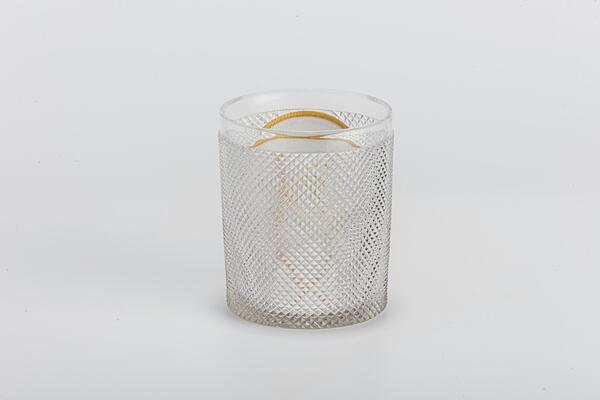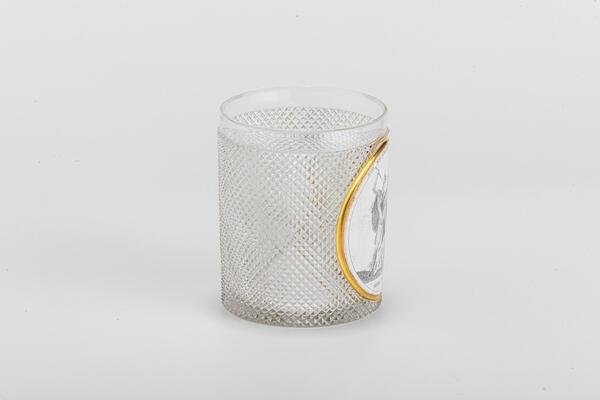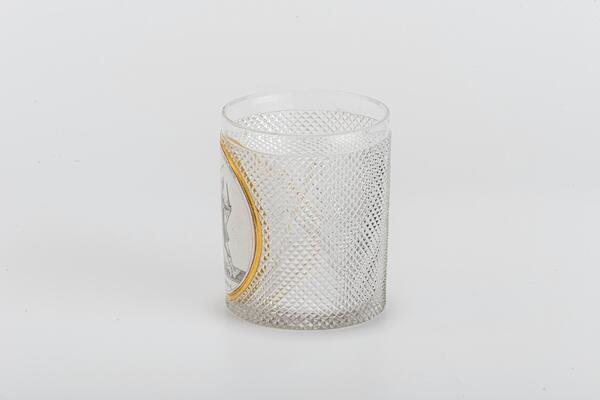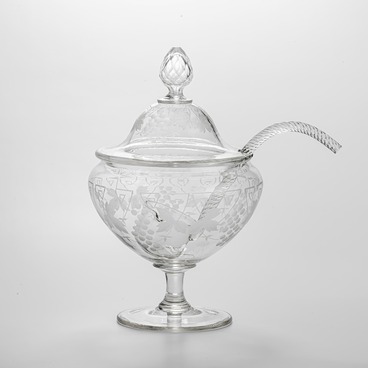The events of the Patriotic War of 1812, one of the glorious pages in the history of Russia, are reflected in many works of art — in literature, fine and applied arts.
Glassmakers both at the Imperial Glass Factory and at private enterprises also addressed this theme. The Nikolsko-Bakhmetevsky enterprise was no exception and the quality of its products was on the same level as the glassware produced in Saint Petersburg.
The exhibits of the Museum of Glass and Crystal dedicated to the Battle of Borodino include a cylindrical colorless glass. Almost the entire surface, with the exception of the top and bottom, is covered with a small sharp stone pattern traditional for Bakhmetevsky products.
The central part of the decoration is a paper sticker with an engraving. The drawing was made according to the medallion by Fyodor Tolstoy. The allegorical image is accompanied by the title: “Battle of Borodino 1812”.
Among the four fighting warriors in the figure, one soldier stands out — he wears a Lobster-tailed pot helmet, light armor and a shirt down to his knees (he is depicted on the left). This is a Russian warrior who fights against two enemies, which indicates the enemy forces outnumbered the Russian ones. However, one of the three enemies has already been defeated: this symbolizes the losses of the French army in the Battle of Borodino, which amounted to a third of its total army.
Count Fyodor Petrovich Tolstoy (1783–1873) was a Russian artist, painter, sculptor and medalist who worked in the style of late Classicism. To commemorate Russia’s victory in the Patriotic War of 1812, he created a series of medallions — relief images in the classic style. They depict scenes of military campaigns in allegorical form. Symbolic figures do not portray any particular individuals, but rather embody the Russian army and militia. The artist wanted the meaning of this allegory to be clear even without any explanation.
The artist worked on this cycle from 1814 to 1836. The reliefs were sculpted from pink wax on black slate boards according to the drawings that had been previously prepared. Then, stamps were cut based on the originals. The items were created not only in plaster, but also in marble, copper, glass and bronze.
Glassmakers both at the Imperial Glass Factory and at private enterprises also addressed this theme. The Nikolsko-Bakhmetevsky enterprise was no exception and the quality of its products was on the same level as the glassware produced in Saint Petersburg.
The exhibits of the Museum of Glass and Crystal dedicated to the Battle of Borodino include a cylindrical colorless glass. Almost the entire surface, with the exception of the top and bottom, is covered with a small sharp stone pattern traditional for Bakhmetevsky products.
The central part of the decoration is a paper sticker with an engraving. The drawing was made according to the medallion by Fyodor Tolstoy. The allegorical image is accompanied by the title: “Battle of Borodino 1812”.
Among the four fighting warriors in the figure, one soldier stands out — he wears a Lobster-tailed pot helmet, light armor and a shirt down to his knees (he is depicted on the left). This is a Russian warrior who fights against two enemies, which indicates the enemy forces outnumbered the Russian ones. However, one of the three enemies has already been defeated: this symbolizes the losses of the French army in the Battle of Borodino, which amounted to a third of its total army.
Count Fyodor Petrovich Tolstoy (1783–1873) was a Russian artist, painter, sculptor and medalist who worked in the style of late Classicism. To commemorate Russia’s victory in the Patriotic War of 1812, he created a series of medallions — relief images in the classic style. They depict scenes of military campaigns in allegorical form. Symbolic figures do not portray any particular individuals, but rather embody the Russian army and militia. The artist wanted the meaning of this allegory to be clear even without any explanation.
The artist worked on this cycle from 1814 to 1836. The reliefs were sculpted from pink wax on black slate boards according to the drawings that had been previously prepared. Then, stamps were cut based on the originals. The items were created not only in plaster, but also in marble, copper, glass and bronze.





